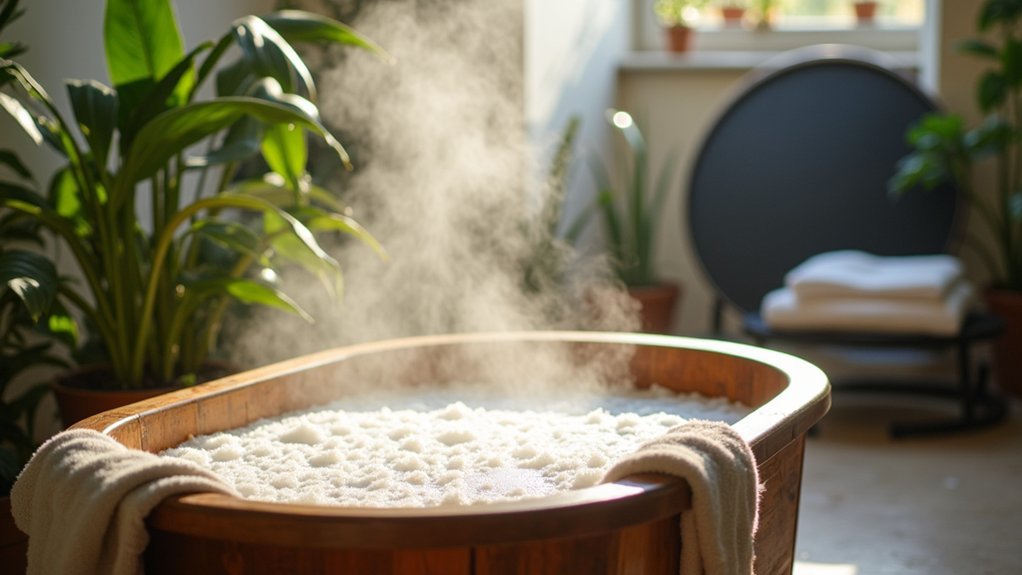After rebounding, your muscles experience unique fatigue due to full-body engagement. Ease this discomfort with an Epsom salt bath at 92°F-100°F for 20-30 minutes. Add two cups of Epsom salt to release magnesium that targets inflammation and relaxes tense calf and thigh muscles. This affordable recovery method works quickly, with relief within 15-20 minutes. Discover how this simple soak can dramatically improve your bounce-back time between trampoline sessions.
Why Rebounding Creates Unique Muscle Fatigue

While most exercises target specific muscle groups sequentially, rebounding creates a distinctive pattern of fatigue by engaging your entire body simultaneously. Each bounce triggers stretch-shortening cycles that activate both fast and slow-twitch muscle fibers, particularly in your legs.
The unique gravitational stimulus during rebounding distributes impact forces throughout your body while challenging your endurance differently than running or strength training. You’ll experience efficient muscle engagement at a lower metabolic cost, but don’t be fooled—this efficiency doesn’t prevent fatigue. This low-impact exercise is particularly beneficial for those with joint concerns who still want an effective full-body workout.
The repetitive bouncing can cause soft tissue inflammation, and the constant muscle contractions deplete energy rapidly. Unlike unilateral exercises that have minimal cross-over effects, rebounding’s full-body workout guarantees thorough muscle fatigue, often requiring longer recovery periods than lower-impact activities.
The Science Behind Epsom Salt Benefits for Rebounders
The unique fatigue pattern caused by rebounding calls for specialized recovery methods. Epsom salt, with its rich magnesium and sulfate content, offers targeted relief for the distinct muscle fatigue you experience after mini-trampoline workouts.
Rebounding creates a distinct fatigue profile that Epsom salt addresses through its natural magnesium-rich formula.
When you soak in an Epsom bath, you’re providing your body with:
- Magnesium absorption – Helps with muscle contraction and relaxation, particularly beneficial for the repetitive bouncing movements.
- Anti-inflammatory effects – Reduces the inflammation caused by the continuous impact of rebounding.
- Muscle tension relief – Promotes relaxation in the calf and thigh muscles most affected by rebounding.
- Natural recovery support – Offers a cost-effective alternative to pharmaceutical options while supporting your body’s natural recovery processes. For optimal results, soak for about 15 minutes in very warm water to maximize the potential benefits.
Ideal Bath Temperature for Post-Trampoline Recovery

Finding the perfect bath temperature after your rebounding session can greatly impact your recovery results. For maximum muscle relaxation and improved performance, aim for hot baths between 37°C-43°C. If inflammation and soreness are your primary concerns, cold immersion between 8°C-15°C works best.
| Bath Type | Temperature | Benefits |
|---|---|---|
| Hot Bath | 37°C-43°C | Muscle relaxation, improved sleep, performance enhancement |
| Cold Bath | 8°C-15°C | Reduced inflammation, mental boost, long-term healing |
| Contrast | Alternating | Extensive recovery benefits |
For ideal results, soak for 20-30 minutes immediately after your trampoline workout. Cold water therapy has shown to reduce muscle soreness by approximately 20% compared to passive recovery methods. You can personalize your experience based on comfort level and specific recovery needs. Remember, consistent temperature throughout your bath guarantees the most effective therapeutic benefits.
Creating the Perfect Post-Rebound Epsom Soak Ritual
Your post-rebound Epsom soak’s effectiveness hinges on water temperature between 98-102°F, which opens pores without stressing your cardiovascular system.
You’ll maximize magnesium absorption by immersing yourself for exactly 20-30 minutes, as shorter sessions limit benefits while longer soaks risk dehydration.
Schedule your bath within 60 minutes after rebounding to capitalize on heightened lymphatic flow, creating the perfect recovery synergy for tired muscles.
Temperature Matters Most
When creating the perfect Epsom salt bath for muscle recovery, temperature stands as the most critical factor determining therapeutic benefit. Your body responds best to a precise thermal range that triggers healing mechanisms without stressing your system.
- Aim for 92°F–100°F (33°C–38°C) – This post-workout sweet spot maximizes muscle relaxation while maintaining safety.
- Never exceed 105°F (40°C) – Higher temperatures risk dehydration, dizziness, and actually impede recovery.
- Use a thermometer – Don’t trust your perception; accurate measurement guarantees therapeutic effectiveness.
- Pre-test with your forearm – Before full immersion, check water comfort with sensitive skin to prevent shock.
Remember to keep water nearby as warm soaks can accelerate fluid loss, and limit sessions to 15-20 minutes for ideal results. For optimal soaking benefits, dissolve two cups of Epsom salt completely in your bath to ensure proper absorption of magnesium and sulfate compounds.
Timed Immersion Protocol
The ideal Epsom soak ritual extends beyond merely filling a tub with salts and water—it demands precise timing and methodical execution to maximize recovery benefits.
For best results, immerse yourself for 15-25 minutes within an hour after your workout. Add 2-4 cups of Epsom salt to your bath and make sure the water covers up to your neck. The magnesium content helps regulate over 300 enzyme reactions essential for muscle recovery and overall health. Aim to soak at least weekly, but ideally after each intense session.
Create a recovery-focused environment with dim lighting and calming music to enhance the relaxation experience. Stay hydrated before, during, and after your soak to prevent dehydration.
Follow your bath with gentle stretching to further improve muscle recovery. This timed approach helps reduce inflammation, decrease cortisol levels, and boost mood-enhancing hormones like serotonin.
Combining Epsom Soaks With Other Recovery Techniques

Maximizing athletic recovery often requires more than a single approach, which is why combining Epsom salt soaks with complementary techniques can considerably enhance your post-workout routine.
For best results, integrate your Epsom soaks strategically with other proven recovery methods. Epsom salt directly helps with reducing inflammation and promotes better circulation throughout the body.
- Compression + Epsom: Use compression wraps during the day for on-the-go recovery, then unwind with an evening Epsom soak for deeper muscle relaxation.
- Active Recovery Pairing: Follow light jogging or cycling with an Epsom bath to improve circulation and enhance magnesium absorption.
- Ice Bath Alternation: For intense workouts, alternate between ice baths to reduce inflammation and Epsom soaks for relaxation.
- Magnesium Flake Option: Consider magnesium flakes instead of Epsom salt when you need quicker absorption for severe muscle cramps.
Real Rebounder Stories: Recovery Experiences With Epsom Salt
Whether through personal testimonials or documented accounts, athletes across disciplines have discovered the restorative powers of Epsom salt soaks for muscle recovery.
Regular users consistently report reduced muscle soreness and tension, with noticeable relief after just 15-20 minutes in warm water with two cups of Epsom salt.
You’ll find that recovery speed improves between training sessions, especially when evening soaks become part of your routine. Many athletes describe these baths as a dual reset—easing both physical tension and mental stress.
For those concerned about inflammation, users report reduced swelling in joints and improved range of motion. The magnesium content in Epsom salt is particularly beneficial as it promotes muscle relaxation and reduces inflammation throughout the body.
The accessibility of Epsom salt makes it a practical addition to any recovery regimen—it’s affordable, portable, and easily integrated into existing routines without significant lifestyle changes.
Frequently Asked Questions
How Long Should I Wait After Rebounding Before Taking an Epsom Bath?
Wait 1-2 hours after rebounding before taking an Epsom salt bath. This cooling-down period prevents muscle shock and overheating. You’ll get better relaxation benefits when your body’s temperature has normalized.
Can I Use Epsom Salts if I Have Sensitive Skin or Skin Conditions?
You can use Epsom salts with sensitive skin, but do a patch test first. Choose fragrance-free formulas, use lukewarm water, limit soaks to 15-20 minutes, and apply moisturizer immediately after bathing.
Are Scented Epsom Salts Less Effective for Muscle Recovery?
Scented Epsom salts aren’t less effective for muscle recovery. You’ll get the same magnesium benefits as unscented versions. The fragrance additives don’t interfere with absorption, though they may provide additional psychological relaxation benefits.
How Often Is Too Often for Epsom Salt Baths After Rebounding?
After rebounding, you shouldn’t take Epsom salt baths more than 2-3 times weekly. Stick to 15-20 minute soaks and stay hydrated. Overuse can cause dehydration, dry skin, and potentially strain your kidneys.
Do Epsom Soaks Help With Rebounding-Related Joint Pain Beyond Muscle Soreness?
Epsom soaks likely won’t greatly help joint pain from rebounding. While the warm water may temporarily soothe discomfort, there’s little evidence for meaningful magnesium absorption or anti-inflammatory effects specifically targeting joint tissues.
In Summary
Whether you’re a committed rebounder or just starting your mini-trampoline journey, don’t underestimate Epsom soaks as part of your recovery toolkit. You’ll find your muscles thanking you after incorporating this simple ritual. Remember, proper temperature, timing, and complementary techniques will maximize your benefits. As countless rebounders have discovered, that perfect balance of bounce and bath creates the ideal fitness experience. Your body deserves this therapeutic finale to each jumping session.





Leave a Reply